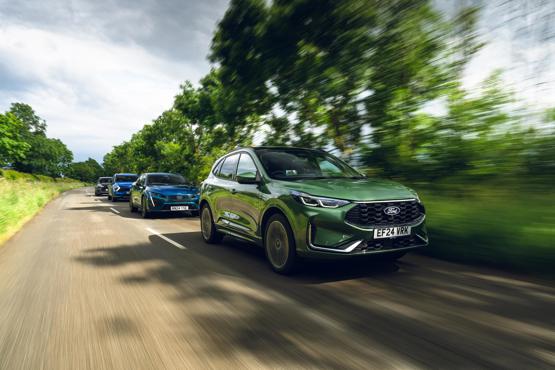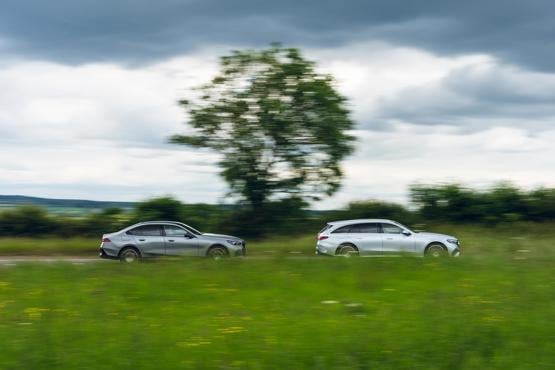The Test | The Cars | The Results | Conclusion
Plug-in hybrids have been a lifeline for the company car driver in recent years as benefit-in-kind (BIK) tax rates soared and the availability of suitable battery electric cars failed to keep pace.
Things might be changing now, but for many drivers the practicality of a plug-in hybrid (PHEV) still holds value. In the first half of 2024, 16% of the cars sold into the true fleet market were PHEVs.
The cars have become a lot more capable, too. Not that long ago we were reporting stories of four-year-old PHEVs returning to auctions with their charging cables still wrapped in plastic. While some of those models could barely manage 20 miles on a charge, the latest versions promise more than double that.
And if used properly, its possible to get some diesel-busting economy figures.
Tax rules mean that a PHEV needs to be able to cover 40 miles (WLTP) on electric power alone to qualify for the 8% BIK rate. Cars that exceed 70 miles in the official test attract just a 5% charge.
Even a basic petrol or diesel car will sit in the 28% band, so the tax savings are certainly significant.
The Test | The Cars | The Results | Conclusion
Plug-in hybrids have been a lifeline for the company car driver in recent years as benefit-in-kind (BIK) tax rates soared and the availability of suitable battery electric cars failed to keep pace.
Things might be changing now, but for many drivers the practicality of a plug-in hybrid (PHEV) still holds value. In the first half of 2024, 16% of the cars sold into the true fleet market were PHEVs.
The cars have become a lot more capable, too. Not that long ago we were reporting stories of four-year-old PHEVs returning to auctions with their charging cables still wrapped in plastic. While some of those models could barely manage 20 miles on a charge, the latest versions promise more than double that.
And if used properly, its possible to get some diesel-busting economy figures.
Tax rules mean that a PHEV needs to be able to cover 40 miles (WLTP) on electric power alone to qualify for the 8% BIK rate. Cars that exceed 70 miles in the official test attract just a 5% charge.
Even a basic petrol or diesel car will sit in the 28% band, so the tax savings are certainly significant.
We’ve assembled a broad group of the most popular PHEV models to see just how capable they are.
The test
The premise of our test is fairly simple. We want to know how far each model can actually go before it runs out of charge and, when the battery is depleted, how fuel efficient the car is when its relying on the internal combustion engine.
By analysing the data, we’ve calculated the cost of a typical 30-mile trip using just electricity or just petrol in each car.

To establish the figures, each car was charged to 100% then driven on a 100-mile loop that included a variety of road types and speed limits.
The cars were driven in their ‘EV’ mode first, so we could record how many miles were covered before the electric ranges reached zero and the engine fired up. We then reset the trip computer and noted the fuel economy figure reported for the remaining journey.
The cars
We settled on eight cars for this test, spanning a variety of segments and price points.
[gallery id=1957]
BMW 5 Series
P11d: £59,400 (530e M Sport) | BIK: 8%
BMW offers the new 5 Series with two plug-in hybrid powertrain options. The 530e is equipped with a 2.0-litre four-cylinder petrol engine, while the 550e uses a 3.0-litre six-cylinder unit. Both cars use the same electric motor and 19.4kWh battery. The 530e sends power to the rear wheels, while the 550e has all-wheel-drive.
We performed our test in both models, although we’ll be focussing on the 530e for this experiment as it’s the more fleet-friendly option.
Ford Kuga
P11d: £40,500 (ST Line) | BIK: 8%
The Kuga PHEV was the UK’s best-selling plug-in hybrid last year. It has since been given a facelift, bringing a refreshed exterior look and a new interior.
The powertrain was carried over, as before. It uses a 2.5-litre naturally aspirated petrol engine that develops 225PS when combined with the car’s electric motor. Power goes to the front wheels via a CVT and the car is fitted with a 14.4kWh battery.
Kia Sportage
P11d: £40,520 (GT Line) | BIK: 8%
Kia may be investing heavily in its fully-electric line-up, but its best-selling model is the Sportage. This mid-size crossover is extremely popular in the fleet market and the Sportage PHEV is a cost-effective choice.
The petrol engine is a 1.6-litre turbocharged unit, shared with the Sportage Hybrid. A larger electric motor gives a power output of 244PS in the PHEV, with power supplied by a 13.8kWh battery.
Mercedes E-Class Estate
P11d: £73,095 (E 300 e AMG Line Premium Plus) | BIK: 8%
The latest-generation E-Class is an evolution of the model that came before. It’s loaded with technology and a new, larger battery. You can have the E 300 e in saloon or estate guise. We opted for the latter. Mercedes is also the only brand to offer a diesel plug-in hybrid, with the E 300 de providing even greater efficiency when using its combustion engine.
A 25.4kWh battery is the second-largest in our test. The car’s powertrain combines a 2.0-litre turbocharged petrol engine with an electric motor, giving a power output of 313PS.
Peugeot 408
P11d: £44,665 (408 PHEV GT 225) | BIK: 12%
Is it a hatch? Is it a saloon? Is it an SUV? Peugeot’s quirky 408 is a family-friendly large car that offers an alternative to the typical mid-size SUV. It uses a Stellantis family powertrain, which is shared with cars like the Citroen C5X and Vauxhall Astra.
It uses the smallest battery of our group, with a capacity of 12.4kWh. Peugeot offers the same powertrain with two power outputs – 180PS and 225PS – our test car is fitted with the more powerful version.
Range Rover Sport
P11d: £93,145 (Sport P460e SE Dynamic) | BIK: 5%
It may be the most expensive car in our group but that hasn’t stopped the Range Rover Sport from being a particularly popular car in the true fleet market. For those that can have one, it makes for an excellent choice. A giant 31.8kWh battery provides a range of more than 70 miles, meaning BIK is just 5%.
Land Rover provided a P440e version for our test, but there is an improved P460e model that has replaced it. The latter has a more efficient and more powerful, electric motor.
Toyota C-HR
P11d: £39,090 ( C-HR PHEV Design) | BIK: 8%
The second-generation C-HR carries over a futuristic body design that makes it stand out in the compact SUV segement.
Toyota has spent the last two decades perfecting its hybrid technology and that experience shows with the C-HR. It uses an efficient 2.0-litre petrol engine and a modest 13.6kWh battery. The powertrain blends petrol and electric power seamlessly. While performance isn’t quite on par with some of the other cars in our test, it does excel when it comes to refinement.
Volvo XC60
P11d: £68,330 (XC60 T8 Ultra) | BIK: 8%
Volvo was among the first to fit plug-in hybrid technology to its cars and the current XC60 benefits from years of development and improvements to the system.
Unlike most PHEV powertrains, the Volvo system – offered in two states of tune - powers each axle independently. The petrol engine handles the front wheels and the electric motor handle the rears. Battery size was increased last year to 14.9kWh, while power output also got a boost. The range-topping T8 version has 455PS.
The results
Let’s start with electric range. The Range Rover Sport promises the longest range of the bunch, at 70 miles. In our test it managed 51.2 miles. While that was among the longest any of the cars managed, it’s the furthest from the official figure.
BMW’s 530e was only one mile behind the Range Rover, achieving 50.2 miles in the test. The all-wheel-drive 550e managed 44.6 miles.
Mercedes takes the crown in this test, however. The E 300 e travelled 54.7 miles on a single charge.

In a clear win for premium brands, the Volvo sits in fourth place, managing 37 miles.
The Toyota C-HR got closest to its WLTP range figure, achieving 36.1 miles, while the Peugeot 408 was the worst performer (26 miles) and the only car not to break the 30-mile barrier.
Ford and Kia might compete closely on paper, but on the road the Sportage claimed a three-mile victory over the Kuga.
|
WLTP range |
Tested Range |
|
|
BMW 530e |
58 |
50.2 |
|
Ford Kuga PHEV |
40 |
30.5 |
|
Kia Sportage PHEV |
41 |
33.3 |
|
Mercedes E 300 e |
68 |
54.7 |
|
Peugeot 408 PHEV |
34 |
26 |
|
Range Rover Sport P440e |
70 |
51.2 |
|
Toyota C-HR PHEV |
41 |
36.1 |
|
Volvo XC60 T8 |
50 |
37 |
As all these cars have differing battery sizes, the maximum range they can travel tells only half the story.
If we look at the miles-per-kilowatt-hour (mi/kWh) achieved by each car then the Toyota comes out on top. It managed 2.7mi/kWh, while the Range Rover Sport moves to the bottom of the table having returned just 1.6mi/kWh.
The BMW impressed with 2.6mi/kWh, as did the XC60 which returned 2.5mi/kWh and was the best-performing SUV.
Once again, Kia trumped Ford with 2.4mi/kWh versus 2.1mi/kWh.
|
Usable battery size (kWh) |
mi/kWh (tested) |
|
|
BMW 530e |
19.4 |
2.6 |
|
Ford Kuga PHEV |
14.4 |
2.1 |
|
Kia Sportage PHEV |
13.8 |
2.4 |
|
Mercedes E 300 e |
25.4 |
2.2 |
|
Peugeot 408 PHEV |
12.4 |
2.1 |
|
Range Rover Sport P440e |
31.8 |
1.6 |
|
Toyota C-HR PHEV |
13.6 |
2.7 |
|
Volvo XC60 T8 |
14.9 |
2.5 |
Switching to petrol-power and, again, the Toyota comes out on top with 53.3mpg achieved. Toyota says the C-HR PHEV operates like a regular hybrid when the charge level is low, so there is always a degree of electric-running.
The Kuga deploys a similar approach - netting it second place, with 50mpg achieved. Interestingly, both these strong performers utilise naturally aspirated engines, rather than turbocharged ones.
Volvo’s engine is both turbocharged and supercharged, which gives strong performance even with a flat battery. The engine proved thirsty, with 33mpg achieved, but was no match for the Range Rover Sport, which managed to guzzle fuel at a rate of 26.9mpg thanks to its mighty 3.0-litre straight six.
The Kia, Peugeot and Mercedes all managed 40mpg, while the 530e nudged 41.
|
MPG (tested) |
|
|
BMW 530e |
41.1 |
|
Ford Kuga |
50.1 |
|
Kia Sportage |
40.9 |
|
Mercedes E 300 e |
40.2 |
|
Peugeot 408 |
40.3 |
|
Range Rover Sport P440e |
26.9 |
|
Toyota C-HR |
53.8 |
|
Volvo XC60 T8 |
33 |
Does it pay to plug in?
Based on our efficiency figures, we totted up the cost of a typical 30-mile journey using just electricity or just petrol in each car.
We used the current energy price cap rate of 23p per kWh for electricity, assuming the cars are charged at home using a domestic socket or wallbox. Drivers that have special off-peak or EV-friendly tariffs can expect lower charging costs.
The fuel price was calculated using the current UK average for unleaded, which is 145p per litre.

The Toyota emerges as the cheapest car to run overall – coincidentally it’s also the cheapest to buy. It could complete a 30-mile trip in EV mode for £2.48.
In every car, electric miles have the lowest cost. The Toyota’s 53.3mpg equates to a cost of £3.69 to cover the same 30-mile journey, if the battery was discharged.
Highlighting how important efficiency is, the Range Rover’s battery would consume £4.20 worth of electricity to drive 30 miles. This is still considerably cheaper than running it purely on petrol, however, at £7.32.
The Ford provides the closest running costs. Its impressive fuel consumption means 30 miles can be covered for £3.96 at the pumps. Using the battery will cost drivers only a little less, at £3.20.
In contrast, Volvo XC60 T8 drivers will be much better off keeping their XC60 charged up. The cost of a 30-mile trip using electricity is less than half that of using the engine.
|
£ per 30 miles EV |
£ per 30 miles fuel |
|
|
BMW 530e |
£2.58 |
£4.81 |
|
Ford Kuga |
£3.20 |
£3.96 |
|
Kia Sportage |
£2.80 |
£4.81 |
|
Mercedes E 300 e |
£3.05 |
£4.94 |
|
Peugeot 408 |
£3.20 |
£4.94 |
|
Range Rover Sport P440e |
£4.20 |
£7.32 |
|
Toyota C-HR |
£2.48 |
£3.69 |
|
Volvo XC60 T8 |
£2.68 |
£6.00 |
Choosing the right PHEV depends heavily on the type of usage it will get. Cars like the E 300 e and Range Rover Sport are great for drivers with lengthy commute, who can make use of their extended ranges.
But, more fugal PHEVs, like the Toyota are the most cost-effective option overall. Budget, of course, plays a part. Most PHEVs carry a weighty premium over their petrol or diesel counterparts. On balance, it’s hard to ignore the BMW 530e, which demonstrates excellent efficiency and a good usable range.
Photography by Jordan Butters.
Login to continue reading.
This article is premium content. To view, please register for free or sign in to read it.





















The Engineer - 05/08/2024 13:51
amongst that test group a Toyota RAV4 might have been a better comparison fit than the C-HR.